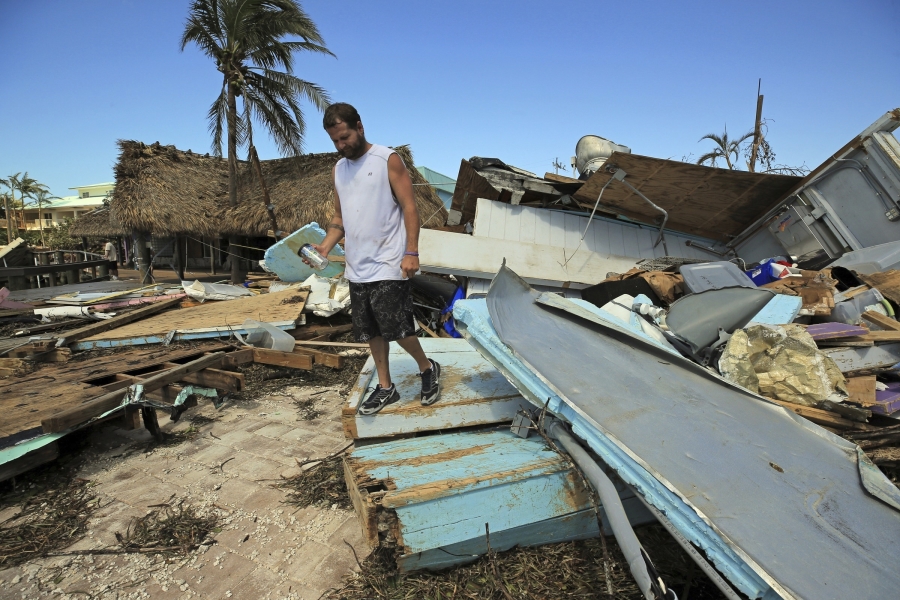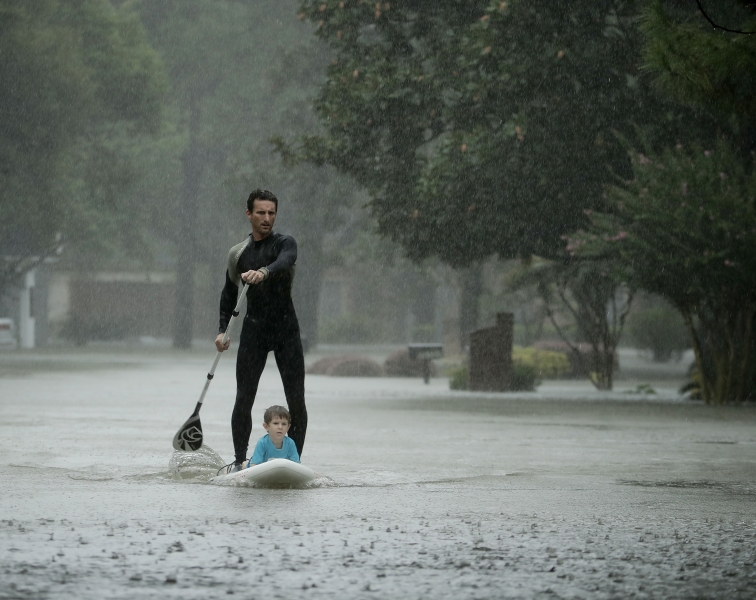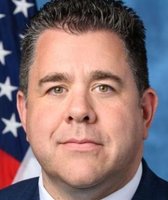Stand up for the facts!
Our only agenda is to publish the truth so you can be an informed participant in democracy.
We need your help.
I would like to contribute
As vast swaths of the country reel from the one-two punch of Hurricanes Harvey and Irma, the focus now is on efforts to help affected states and communities recover from the devastation.
Natural disasters often leave in their wake a years-long process of rebuilding homes, repairing buildings and restoring infrastructure.
As this arduous task opens on several new fronts, we decided to take a closer look at how money flows into and out of federal disaster relief coffers.
Multiple agencies play a part in the nation’s disaster recovery. But with FEMA’s role in the Hurricane Katrina response still fresh in public memory, the funding source Americans are most familiar with is likely FEMA’s disaster relief fund.
A sequence of steps, defined by law, typically takes place before the federal government turns on FEMA’s disaster relief spigot.
Sign up for PolitiFact texts
If local officials believe the scale of a disaster is beyond their capacity, a governor can ask the president for help. FEMA then makes a recommendation to the president, who chooses whether to officially declare a major disaster or emergency. Both declaration types trigger federal disaster assistance, but the aid varies in amount and scope
A wide spectrum of events, from highly destructive incidents to more routine occurrences, can qualify for federal aid, and the president can declare a disaster even before its full brunt has been borne. A Congressional Research Service flowchart depicts the typical chain of events that triggers federal relief for a major disaster. (Note that some disaster relief activities don’t require a presidential declaration.)
President Donald Trump’s Twitter feed showed this process play out in real time as Hurricane Harvey barreled toward the Gulf Coast on Aug. 25.
Trump tweeted around noon Eastern time that he had been in touch with Govs. Greg Abbott of Texas and John Bel Edwards of Louisiana, and that the federal government was keeping a close eye on developments.
"I have spoken w/ @GovAbbott of Texas and @LouisianaGov Edwards. Closely monitoring #HurricaneHarvey developments & here to assist as needed," Trump tweeted at 11:46 a.m.
I have spoken w/ @GovAbbott of Texas and @LouisianaGov Edwards. Closely monitoring #HurricaneHarvey developments & here to assist as needed.
— Donald J. Trump (@realDonaldTrump) August 25, 2017
A short period later, Trump tweeted that he had been briefed on Hurricane Harvey by FEMA Administrator Brock Long and other advisers that morning.
"Received a #HurricaneHarvey briefing this morning from Acting @DHSgov Secretary Elaine Duke, @FEMA_Brock, @TomBossert45 and COS John Kelly," Trump tweeted at 12:02 p.m.
Received a #HurricaneHarvey briefing this morning from Acting @DHSgov Secretary Elaine Duke, @FEMA_Brock, @TomBossert45 and COS John Kelly. pic.twitter.com/cnkRZd6D6Z
— Donald J. Trump (@realDonaldTrump) August 25, 2017
At 7 p.m. that evening, the National Hurricane Center upgraded Harvey to a Category 4 hurricane, with maximum sustained winds of 130 mph, and "sustained hurricane-force winds spreading onto the middle Texas coast." Landfall looked imminent.
Before Harvey touched down outside Corpus Christi, Trump announced over Twitter that he had signed a disaster proclamation at Abbott’s request.
"At the request of the Governor of Texas, I have signed the Disaster Proclamation, which unleashes the full force of government help!" Trump tweeted at 9:46 p.m.
At the request of the Governor of Texas, I have signed the Disaster Proclamation, which unleashes the full force of government help!
— Donald J. Trump (@realDonaldTrump) August 26, 2017
Technically speaking, Trump declared a major disaster in Texas, and declared an emergency three days later in Louisiana, also due to Harvey.
In September, Trump made major disaster and emergency declarations in response to Hurricane Irma.
Once the president declares a major disaster, FEMA disburses funds to the state for eligible projects under the following categories, according to the Congressional Research Service:
-
Public Assistance. This is FEMA’s largest funded program. It helps communities pay for things like debris removal and repairs to infrastructure, including public buildings, roads, bridges and utilities. Robert B. Olshansky, a professor of urban and regional planning at the University of Illinois (Urbana-Champaign), likened this to a federal insurance policy where taxpayers foot the premium.
-
Individual Assistance. This includes things like housing for displaced people, grants to provide for needs that are outside the scope of insurance payments, crisis counseling and unemployment assistance for those who can’t work as a result of the disaster.
-
Hazard Mitigation. A FEMA grant program funds measures to prevent or lessen the effects of a future disaster, like elevating one’s home to avoid potential floodwaters. Mitigation funding is a fraction of the amount spent on the other two categories, Olshansky said.
In its regular course of business, Congress each year sends two pots of money to FEMA’s disaster relief fund, the nation’s main disaster relief bank account.
The first pot, known as base funding, is the smaller of the two. It’s based on a formula pegged to ordinary FEMA operations and more routine events. In fiscal 2017, base funding was $615 million.
The second pot of money Congress gives FEMA is much bigger. Called Major Declarations, it’s based on how much was spent on disaster relief in the past decade. In fiscal 2017, that appropriation was $6.7 billion.
Together, base and major declaration funding totaled $7.3 billion in fiscal 2017. (FEMA can also carry over any unspent funds from the previous year.)
That may sound like a lot of money. But compared with an estimate by Moody’s Analytics, which places the combined damage from hurricanes Harvey and Irma at $150 billion to $200 billion, it’s a drop in the bucket.
So what happens when disaster recovery outstrips FEMA funding?
The task then falls to Congress to release more money, in the form of supplemental appropriations.
Lawmakers did just that on Sept. 8 when they approved more than $15 billion for additional Harvey relief. That includes the following:
-
$7.4 billion for FEMA's Disaster Relief Fund
-
$7.4 billion in Community Development Block Grant funding, which is administered through the Department of Housing and Urban Development
-
$450 million for the Small Business Administration's Disaster Loan Program
In a Sept. 11 press briefing, White House homeland security adviser Tom Bossert said a second appropriation would come at the end of September, and that federal officials would later seek a third and "perhaps a fourth" appropriation.
If history is any guide, Bossert has reason to be confident Congress will approve more funding, given its solid track record of replenishing FEMA’s depleted disaster relief fund.
According to the Congressional Research Service, Congress made 14 supplemental appropriations from 2004 and 2013, totaling $89.6 billion. That includes $43 billion in 2005 alone, the year Hurricanes Katrina, Wilma and Rita hit the United States.
Our Sources
FEMA, "Robert T. Stafford Disaster Relief and Emergency Assistance Act (Public Law 93-288) as amended," Jan. 20, 2016
FEMA, "The Disaster Declaration Process"
FEMA, "Homeowner’s Guide to the Hazard Mitigation Grant Program"
FEMA, "Disaster Relief Fund: Monthly Report," Aug. 7, 2017
Congressional Research Service, "FEMA’s Disaster Relief Fund: Overview and Selected Issues," May 7, 2014
Congressional Research Service, "An Examination of Federal Disaster Relief Under the Budget Control Act," Feb. 24, 2016
Congressional Research Service, "Stafford Act Assistance and Acts of Terrorism," June 2, 2017
Tweet by Donald Trump, Aug. 25, 2017
Tweet by Donald Trump, Aug. 25, 2017
Tweet by Donald Trump, Aug. 25, 2017
White House press release, "President Donald J. Trump Approves Texas Disaster Declaration," Aug. 25, 2017
White House press release, "President Donald J. Trump Approves Louisiana Emergency Declaration," Aug. 28, 2017
White House press release, "President Donald J. Trump Amends U.S. Virgin Islands Disaster Declaration," Sept. 10, 2017
White House press release, "President Donald J. Trump Approves Puerto Rico Disaster Declaration," Sept. 10, 2017
White House press release, "President Donald J. Trump Approves Florida Disaster Declaration," Sept. 10, 2017
White House press release, "President Donald J. Trump Approves Alabama Emergency Declaration," Sept. 11, 2017
White House press release, "President Donald J. Trump Approves Georgia Emergency Declaration," Sept. 8, 2017
Text of supplemental appropriations legislation, "H.R.601"
National Hurricane Center update, Aug. 25, 2017
National Hurricane Center update, Aug. 25, 2017
New York Times, "From Forecast to Disaster: A Timeline at the National Hurricane Center," Aug. 30, 2017
Reuters, "Moody's Analytics sees economic cost of Irma at $64-92 billion," Sept. 12, 2017
Interview with Robert B. Olshansky, urban and regional planning professor at the University of Illinois (Urbana-Champaign), Sept. 13, 2017
Interview with Steve Ellis, vice president, Taxpayers for Common Sense, Sept. 14, 2017

 Eric Ward, the bartender at Key Largo's Snappers inspects the damage from Hurricane Irma at the popular restaurant Tuesday, Sept. 12, 2017, in Key Largo, Fla. Florida is cleaning up and embarking on rebuilding from Hurricane Irma, one of the most destructive hurricanes in its history. (Al Diaz/Miami Herald via AP)
Eric Ward, the bartender at Key Largo's Snappers inspects the damage from Hurricane Irma at the popular restaurant Tuesday, Sept. 12, 2017, in Key Largo, Fla. Florida is cleaning up and embarking on rebuilding from Hurricane Irma, one of the most destructive hurricanes in its history. (Al Diaz/Miami Herald via AP) In this Monday, Aug. 28, 2017 file photo, Alexendre Jorge evacuates Ethan Colman, 4, from a neighborhood inundated by floodwaters from Tropical Storm Harvey in Houston, Texas. (AP Photo/Charlie Riedel)
In this Monday, Aug. 28, 2017 file photo, Alexendre Jorge evacuates Ethan Colman, 4, from a neighborhood inundated by floodwaters from Tropical Storm Harvey in Houston, Texas. (AP Photo/Charlie Riedel)











































